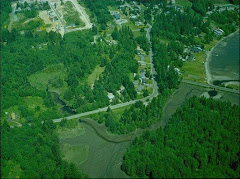“Why have we been working on these symptoms for so long and so hard; and even with so many successful programs, why have we seen too little fundamental change?” asks Peter Block in his book Community; The Structure of Belonging. His answer: “a breakdown of community.” When this idea is applied to salmon recovery and stream restoration, it sheds some light on our ongoing struggle to find effective and long lasting solutions.
The question of what causes the deterioration of our streams and rivers is a complex question indeed, but one that is worth some heavy consideration. We can identify the physical threats such as dams, culverts, clear cutting, erosion and so on, and consequently we have put in place regulations such as permits and fines. However, the conditions of our streams and salmon populations continue to decline. How is it that even though we know that these and similar degrading activities greatly impact watersheds, they continue to happen anyway. It’s not that the people who build dams, overgraze riparian areas, or clear cut in sensitive drainages have malicious intentions to destroy streams and deserve all the blame. Rather it seems like the root of the problem is that as a society we allow this to happen. Why? Perhaps it is because of this “breakdown of community” that Block suggests. We have lost touch with our rivers and streams to such an extent that these violations have become normalized. Not on purpose of course, but as a result of our overbooked lives and the shortsighted nature of our culture. Majority of us have forgotten the services these streams provide and how important they are for the health of the surrounding communities, humans included.
It seems like if we really want to get in front of these destructive patterns, we need to begin to restore our personal relationships with our watersheds. When people have a strong connection to an area, it seems like they are more likely to ensure that it is properly taken care of. Finding ways to reconnect communities to the local streams and rivers becomes the other component to the physical environmental restoration projects. If the restoration community can find ways to validate and help cultivate these relationships, we will then start to get ahead in the protection and preservation of our watersheds.
Block, P. 2008. Community; The Structure of Belonging. Berrett-Koehler Publishers, Inc., CA. pg.34
Friday, February 19, 2010
Subscribe to:
Post Comments (Atom)

No comments:
Post a Comment